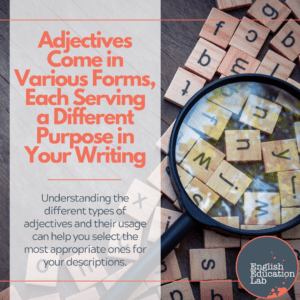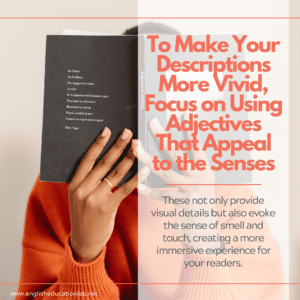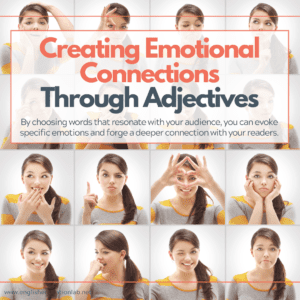
Adjectives amplified: Unlocking the power of descriptive language
Step into a world reimagined through the vivid lens of adjectives. In this post, we’ll explore the transformative power of descriptive language, uncovering the secrets to making your written and spoken English captivating, colorful, and utterly unforgettable. Whether you’re an ESL student, aspiring writer or a seasoned wordsmith, understanding how to wield adjectives with precision can elevate your storytelling to new heights. 
With their ability to accentuate emotions, paint vivid imagery, and create memorable experiences, adjectives have the power to transport your readers and listeners to another realm. From the tantalizing aroma of freshly brewed coffee to the awe-inspiring beauty of a breathtaking sunset, adjectives breathe life into every description, invoking a sensory experience that lingers in the mind long after the words have been read!
In this article, we delve into the art of employing adjectives in your writing, providing practical tips and techniques to help you craft engaging, evocative prose. We’ll explore the importance of choosing the right adjectives, avoiding clichés, and striking a balance between powerful and excessive language. Get ready to unleash the full potential of adjectives and captivate your audience like never before.
The importance of using adjectives in writing
Adjectives play a crucial role in writing by adding depth and detail to your descriptions. They help to bring characters, settings, and objects to life, making them more relatable and engaging for your readers. Without them, your writing can feel flat and lackluster, failing to evoke the desired emotions or create a lasting impact and nobody wants that, right?
Additionally, adjectives allow you to express your unique perspective and voice as a writer. They provide you with the opportunity to infuse your writing with your personal style and creativity, enabling you to create a distinct and memorable reading experience.
How adjectives enhance descriptions
Adjectives have the power to enhance descriptions by adding specificity and nuance. By carefully selecting the right ones, you can paint a vivid picture in the minds of your readers, enabling them to visualize and experience what you’re describing. For example, instead of simply saying “the house was old,” you can use adjectives like “weathered,” “crumbling,” or “time-worn” to create a more evocative and immersive description.
Furthermore, adjectives can evoke emotions and set the tone of your writing. By choosing descriptive language that conveys the desired mood, you can elicit specific emotional responses from your readers. For instance, using words like “haunting,” “melancholic,” or “bittersweet” can create a sense of nostalgia or melancholy, while adjectives like “exhilarating,” “thrilling,” or “heart-pounding” can generate excitement and anticipation.
Types of adjectives and their usage
Descriptive language comes in various forms, each serving a different purpose in your writing. Understanding the different types of adjectives and their usage can help you select the most appropriate ones for your descriptions. Here are some to take note of:

1. Descriptive adjectives: These words provide specific details about a noun, such as its appearance, size, color, or shape. For example, “beautiful,” “enormous,” “blue,” and “oval” are all words that add visual information to your writing.
2. Emotional adjectives: These describe the emotions or feelings associated with a noun. They help to create a more immersive and relatable experience for your readers. Some examples include “joyful,” “heartbroken,” “terrified,” and “serene.”
3. Comparative adjectives: These words are used to compare two or more things. They indicate whether something has more or less of a certain quality compared to another. Examples of comparative adjectives include “bigger,” “faster,” “smarter,” and “more beautiful.”
4. Superlative adjectives: These are used to compare three or more things and indicate the highest degree of a certain quality. Superlative adjectives often end in “-est” or are preceded by “most.” Examples include “biggest,” “fastest,” “smartest,” and “most beautiful.”
Techniques for choosing the right adjectives
Choosing the right descriptive language can make all the difference in creating compelling and impactful writing. Here are some techniques to help you select the most effective adjectives:
1. Be specific: Instead of opting for generic adjectives, strive to be as specific as possible. Rather than saying something is “nice,” consider using words like “charming,” “delightful,” or “captivating” to provide a clearer and more engaging description.
2. Consider the connotation: Adjectives carry connotations, which can influence how your readers perceive your writing. For example, using words like “luxurious,” “opulent,” or “lavish” creates a different impression compared to using adjectives like “expensive” or “pricey.” Consider the connotations of the descriptive language you choose and how it aligns with your desired tone and message.
3. Use sensory language: Adjectives that appeal to the senses can enhance your descriptions and make them more immersive.
4. Incorporate descriptive language: Words that evoke sight, sound, smell, taste, and touch create a multi-dimensional experience for your readers. For instance, instead of saying “the coffee tasted good,” you could say “the coffee tasted rich and velvety.”
Using descriptive adjectives to paint vivid pictures
The use of descriptive language is invaluable when it comes to painting vivid pictures in the minds of your readers. They allow you to go beyond the surface-level details and delve deeper into the essence of what you’re describing. By incorporating descriptive adjectives, you can create a more engaging and memorable reading experience.

To make your descriptions more vivid, focus on using adjectives that appeal to the senses. For example, instead of saying “the house had a garden,” you could say “the house had a lush, vibrant garden filled with fragrant flowers and towering trees.” This description not only provides visual details but also evokes the sense of smell and touch, creating a more immersive experience for your readers.
The impact of adjectives on storytelling
Descriptive language plays a crucial role in storytelling by shaping the atmosphere, setting, and characters in your narrative. They help to establish the tone and mood of your story, allowing your readers to fully immerse themselves in the world you’ve created.
By carefully selecting words that align with the desired emotional impact, you can enhance the dramatic tension, evoke empathy for your characters, and create a more compelling narrative. For example, using words like “foreboding,” “sinister,” or “ominous” can create a sense of impending danger or suspense, keeping your readers on the edge of their seats.
Creating emotional connections through adjectives
Descriptive language has the power to create emotional connections between your readers and your writing. By choosing words that resonate with your audience, you can evoke specific emotions and forge a deeper connection with your readers.
Consider your target audience and the emotions you want to elicit. Are you writing a heartwarming story that aims to evoke feelings of nostalgia and warmth? In that case, words like “nostalgic,” “heartfelt,” and “endearing” can help create the desired emotional impact. By understanding your audience and tailoring your word choices accordingly, you can create a more meaningful and engaging reading experience.
Exercises to improve adjective usage in writing
Mastering the art of descriptive language usage takes practice. Here are a few exercises to help you improve your skills:
1. Word association: Choose a noun and write down as many adjectives as you can that describe it. Push yourself to think beyond the obvious choices and explore different angles and perspectives.

2. Sensory exploration: Take a moment to observe your surroundings and describe what you see, hear, smell, taste, and touch using descriptive language. This exercise will help you sharpen your senses and expand your vocabulary.
3. Rewriting exercises: Take a piece of writing and rewrite it, focusing on incorporating more descriptive and engaging adjectives. Compare the original and revised versions to see the impact of your adjective choices.
Harnessing the power of adjectives in your writing
Descriptive language is the key to unlocking the full potential of your writing. It has the ability to captivate your readers, paint vivid pictures, and create lasting impressions. By choosing the right adjectives, employing descriptive language, and understanding their impact on storytelling, you can elevate your writing to new heights.
So, unleash the power of adjectives and let your words mesmerize and inspire. Embrace the colorful world they create and watch as your writing comes alive in the minds of your readers. With adjectives as your allies, the possibilities are boundless.
Get your ‘Free Cheat Sheet on Understanding the English Articles’ here!
Get your ‘Free Guide to Speaking English with Confidence- Your 5-Step Roadmap’ here!
Subscribe to my YouTube Channel!
Further Reading
Mastering the art of intonation: A guide to effective communication
From above to below: Understanding the different prepositions of place
Mastering transitional words: How to give your writing a seamless flow
Demystifying the present perfect tense: From confusion to clarity
Social media slang: Boost your online communication skills with these must-know terms


Top 5 ways of improving your English vocabulary over the summer

